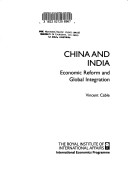The potential for economic liberalisation and growth in the world's two most populous countries, China and India, has attracted a great deal of interest during recent months. If both, or even one, of them manage a breakthrough to sustained rapid development comparable with that achieved in smaller East Asian economies, it will be of historic significance not just for the countries themselves but for the rest of the world. The opportunities and risks associated with development in both countries are clearly apparent. China has just enjoyed three years of growth at a scarcely credible level of over 13 per cent, although there is serious political uncertainty with the imminent death of Deng Xiaoping. Over the same period, India has dismantled a significant part of the system of administrative controls that had closed the country to foreign investment and stifled the private sector. But its weaknesses have been highlighted by widespread civil strife, an epidemic of the plague and a good deal of short-term political instability. Both countries have great potential for development and for disaster.
By examining some of the common features and experiences, as well as some fundamental differences, China and India takes a comparative look at recent reforms, their origin and effects, and at the wider implications of the two countries becoming a significant force in world trade and capital flows.
- ISBN10 1899658009
- ISBN13 9781899658008
- Publish Date 30 November 1995
- Publish Status Out of Print
- Out of Print 24 March 2015
- Publish Country GB
- Imprint Royal Institute of International Affairs
- Format Paperback
- Pages 80
- Language English
